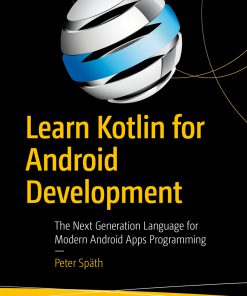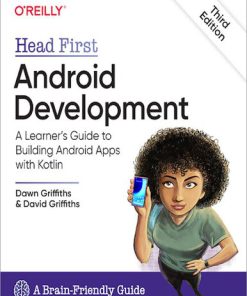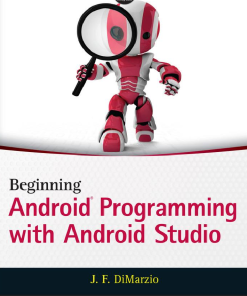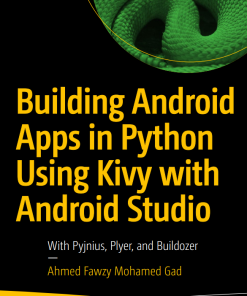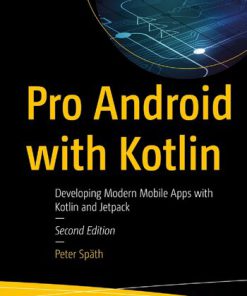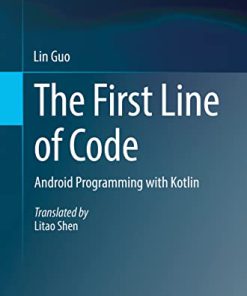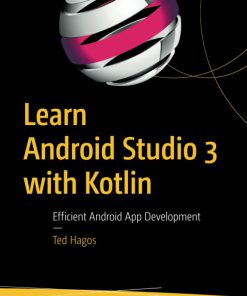Android Studio Electric Eel Essentials Kotlin Edition Developing Android Apps Using Android Studio 2022 1 1 and Kotlin 1st edition Neil Smyth 1951442571 9781951442576
$50.00 Original price was: $50.00.$25.00Current price is: $25.00.
Android Studio Electric Eel Essentials Kotlin Edition Developing Android Apps Using Android Studio 2022 1 1 and Kotlin 1st edition Neil Smyth – Ebook PDF Instant Download/Delivery: 1951442571, 9781951442576
Full download Android Studio Electric Eel Essentials Kotlin Edition Developing Android Apps Using Android Studio 2022 1 1 and Kotlin 1st Edition after payment
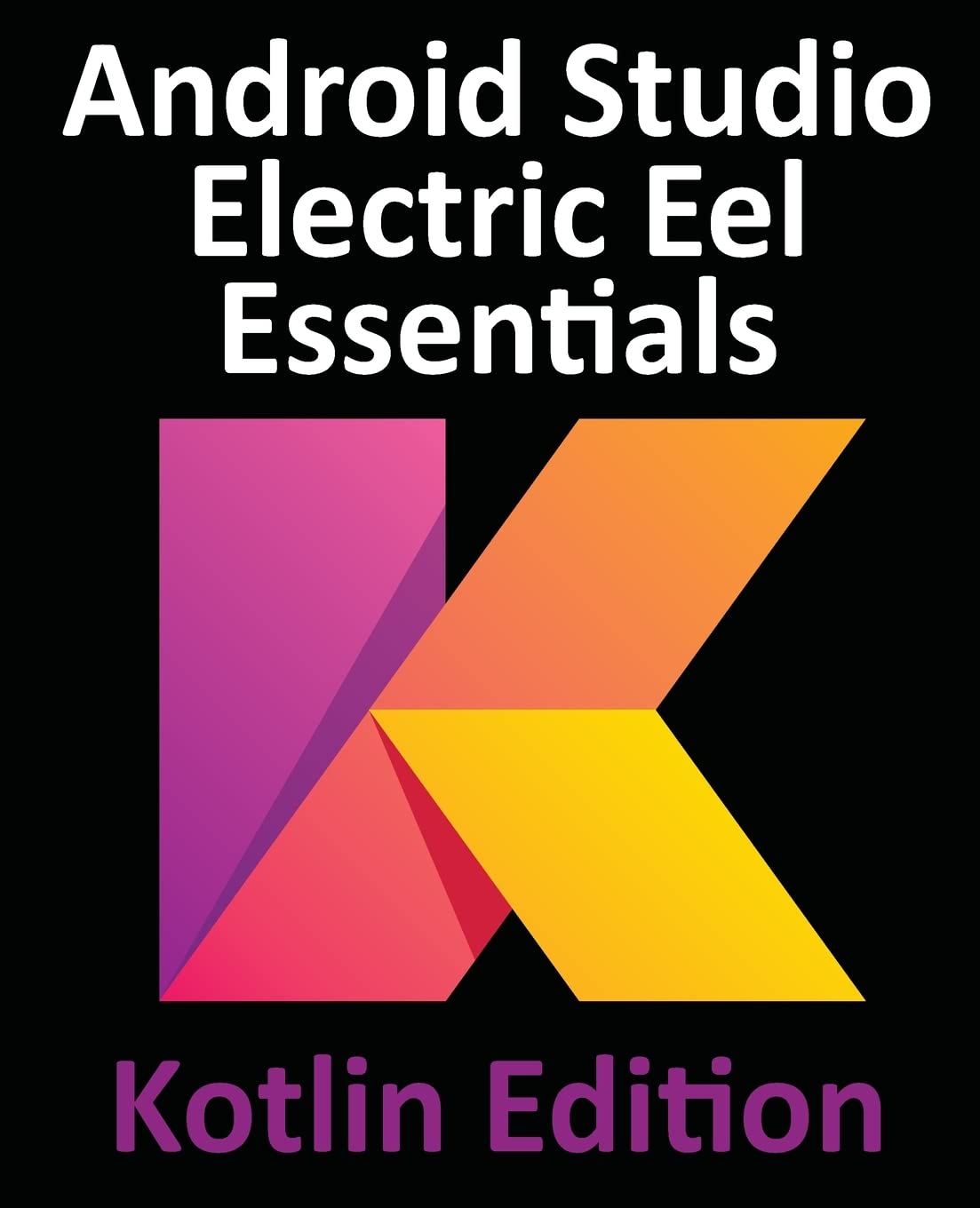
Product details:
ISBN 10: 1951442571
ISBN 13: 9781951442576
Author: Neil Smyth
Fully updated for Android Studio Electric Eel, this book aims to teach you how to develop Android-based applications using the Kotlin programming language.
This book begins with the basics and outlines the steps necessary to set up an Android development and testing environment followed by an introduction to programming in Kotlin, including data types, control flow, functions, lambdas, and object-oriented programming. Asynchronous programming using Kotlin coroutines and flow is also covered in detail.
An overview of Android Studio is included covering areas such as tool windows, the code editor, and the Layout Editor tool. An introduction to the architecture of Android is followed by an in-depth look at the design of Android applications and user interfaces using the Android Studio environment.
Chapters are also included covering the Android Architecture Components including view models, lifecycle management, Room database access, the Database Inspector, app navigation, live data, and data binding.
More advanced topics such as intents are also covered, as are touch screen handling, gesture recognition, and the recording and playback of audio. This edition of the book also covers printing, transitions, and foldable device support.
The concepts of material design are also covered in detail, including the use of floating action buttons, Snackbars, tabbed interfaces, card views, navigation drawers, and collapsing toolbars.
Other key features of Android Studio and Android are also covered in detail, including the Layout Editor, the ConstraintLayout and ConstraintSet classes, MotionLayout Editor, view binding, constraint chains, barriers, and direct reply notifications.
Chapters also cover advanced features of Android Studio, such as App Links, Dynamic Delivery, Gradle build configuration, in-app billing, and submitting apps to the Google Play Developer Console.
Assuming you already have some programming experience, are ready to download Android Studio and the Android SDK, have access to a Windows, Mac, or Linux system, and have ideas for some apps to develop, you are ready to get started.
Android Studio Electric Eel Essentials Kotlin Edition Developing Android Apps Using Android Studio 2022 1 1 and Kotlin 1st Table of contents:
1. Introduction
1.1 Downloading the Code Samples
1.2 Feedback
1.3 Errata
2. Setting up an Android Studio Development Environment
2.1 System requirements
2.2 Downloading the Android Studio package
2.3 Installing Android Studio
2.3.1 Installation on Windows
2.3.2 Installation on macOS
2.3.3 Installation on Linux
2.4 Installing additional Android SDK packages
2.5 Installing the Android SDK Command-line Tools
2.5.1 Windows 8.1
2.5.2 Windows 10
2.5.3 Windows 11
2.5.4 Linux
2.5.5 macOS
2.6 Android Studio memory management
2.7 Updating Android Studio and the SDK
2.8 Summary
3. Creating an Example Android App in Android Studio
3.1 About the Project
3.2 Creating a New Android Project
3.3 Creating an Activity
3.4 Defining the Project and SDK Settings
3.5 Modifying the Example Application
3.6 Modifying the User Interface
3.7 Reviewing the Layout and Resource Files
3.8 Adding Interaction
3.9 Summary
4. Creating an Android Virtual Device (AVD) in Android Studio
4.1 About Android Virtual Devices
4.2 Starting the Emulator
4.3 Running the Application in the AVD
4.4 Running on Multiple Devices
4.5 Stopping a Running Application
4.6 Running the Emulator in a Separate Window
4.7 Removing the Device Frame
4.8 Summary
5. Using and Configuring the Android Studio AVD Emulator
5.1 The Emulator Environment
5.2 Emulator Toolbar Options
5.3 Working in Zoom Mode
5.4 Resizing the Emulator Window
5.5 Extended Control Options
5.5.1 Location
5.5.2 Displays
5.5.3 Cellular
5.5.4 Battery
5.5.5 Camera
5.5.6 Phone
5.5.7 Directional Pad
5.5.8 Microphone
5.5.9 Fingerprint
5.5.10 Virtual Sensors
5.5.11 Snapshots
5.5.12 Record and Playback
5.5.13 Google Play
5.5.14 Settings
5.5.15 Help
5.6 Working with Snapshots
5.7 Configuring Fingerprint Emulation
5.8 The Emulator in Tool Window Mode
5.9 Common Android Settings
5.10 Creating a Resizable Emulator
5.11 Summary
6. A Tour of the Android Studio User Interface
6.1 The Welcome Screen
6.2 The Menu Bar
6.3 The Main Window
6.4 The Tool Windows
6.5 The Tool Window Menus
6.6 Android Studio Keyboard Shortcuts
6.7 Switcher and Recent Files Navigation
6.8 Changing the Android Studio Theme
6.9 Summary
7. Testing Android Studio Apps on a Physical Android Device
7.1 An Overview of the Android Debug Bridge (ADB)
7.2 Enabling USB Debugging ADB on Android Devices
7.2.1 macOS ADB Configuration
7.2.2 Windows ADB Configuration
7.2.3 Linux adb Configuration
7.3 Resolving USB Connection Issues
7.4 Enabling Wireless Debugging on Android Devices
7.5 Testing the adb Connection
7.6 Device Mirroring
7.7 Summary
8. The Basics of the Android Studio Code Editor
8.1 The Android Studio Editor
8.2 Splitting the Editor Window
8.3 Code Completion
8.4 Statement Completion
8.5 Parameter Information
8.6 Parameter Name Hints
8.7 Code Generation
8.8 Code Folding
8.9 Quick Documentation Lookup
8.10 Code Reformatting
8.11 Finding Sample Code
8.12 Live Templates
8.13 Summary
9. An Overview of the Android Architecture
9.1 The Android Software Stack
9.2 The Linux Kernel
9.3 Hardware Abstraction Layer
9.4 Android Runtime – ART
9.5 Android Libraries
9.5.1 C/C++ Libraries
9.6 Application Framework
9.7 Applications
9.8 Summary
10. The Anatomy of an Android App
10.1 Android Activities
10.2 Android Fragments
10.3 Android Intents
10.4 Broadcast Intents
10.5 Broadcast Receivers
10.6 Android Services
10.7 Content Providers
10.8 The Application Manifest
10.9 Application Resources
10.10 Application Context
10.11 Summary
11. An Introduction to Kotlin
11.1 What is Kotlin?
11.2 Kotlin and Java
11.3 Converting from Java to Kotlin
11.4 Kotlin and Android Studio
11.5 Experimenting with Kotlin
11.6 Semi-colons in Kotlin
11.7 Summary
12. Kotlin Data Types, Variables, and Nullability
12.1 Kotlin Data Types
12.1.1 Integer Data Types
12.1.2 Floating-Point Data Types
12.1.3 Boolean Data Type
12.1.4 Character Data Type
12.1.5 String Data Type
12.1.6 Escape Sequences
12.2 Mutable Variables
12.3 Immutable Variables
12.4 Declaring Mutable and Immutable Variables
12.5 Data Types are Objects
12.6 Type Annotations and Type Inference
12.7 Nullable Type
12.8 The Safe Call Operator
12.9 Not-Null Assertion
12.10 Nullable Types and the let Function
12.11 Late Initialization (lateinit)
12.12 The Elvis Operator
12.13 Type Casting and Type Checking
12.14 Summary
13. Kotlin Operators and Expressions
13.1 Expression Syntax in Kotlin
13.2 The Basic Assignment Operator
13.3 Kotlin Arithmetic Operators
13.4 Augmented Assignment Operators
13.5 Increment and Decrement Operators
13.6 Equality Operators
13.7 Boolean Logical Operators
13.8 Range Operator
13.9 Bitwise Operators
13.9.1 Bitwise Inversion
13.9.2 Bitwise AND
13.9.3 Bitwise OR
13.9.4 Bitwise XOR
13.9.5 Bitwise Left Shift
13.9.6 Bitwise Right Shift
13.10 Summary
14. Kotlin Control Flow
14.1 Looping Control flow
14.1.1 The Kotlin for-in Statement
14.1.2 The while Loop
14.1.3 The do … while loop
14.1.4 Breaking from Loops
14.1.5 The continue Statement
14.1.6 Break and Continue Labels
14.2 Conditional Control Flow
14.2.1 Using the if Expressions
14.2.2 Using if … else … Expressions
14.2.3 Using if … else if … Expressions
14.2.4 Using the when Statement
14.3 Summary
15. An Overview of Kotlin Functions and Lambdas
15.1 What is a Function?
15.2 How to Declare a Kotlin Function
15.3 Calling a Kotlin Function
15.4 Single Expression Functions
15.5 Local Functions
15.6 Handling Return Values
15.7 Declaring Default Function Parameters
15.8 Variable Number of Function Parameters
15.9 Lambda Expressions
15.10 Higher-order Functions
15.11 Summary
16. The Basics of Object Oriented Programming in Kotlin
16.1 What is an Object?
16.2 What is a Class?
16.3 Declaring a Kotlin Class
16.4 Adding Properties to a Class
16.5 Defining Methods
16.6 Declaring and Initializing a Class Instance
16.7 Primary and Secondary Constructors
16.8 Initializer Blocks
16.9 Calling Methods and Accessing Properties
16.10 Custom Accessors
16.11 Nested and Inner Classes
16.12 Companion Objects
16.13 Summary
17. An Introduction to Kotlin Inheritance and Subclassing
17.1 Inheritance, Classes and Subclasses
17.2 Subclassing Syntax
17.3 A Kotlin Inheritance Example
17.4 Extending the Functionality of a Subclass
17.5 Overriding Inherited Methods
17.6 Adding a Custom Secondary Constructor
17.7 Using the SavingsAccount Class
17.8 Summary
18. An Overview of Android View Binding
18.1 Find View by Id
18.2 View Binding
18.3 Converting the AndroidSample project
18.4 Enabling View Binding
18.5 Using View Binding
18.6 Choosing an Option
18.7 View Binding in the Book Examples
18.8 Migrating a Project to View Binding
18.9 Summary
19. Introducing Gemini in Android Studio
19.1 Introducing Gemini AI
19.2 Enabling Gemini in Android Studio
19.3 Gemini configuration
19.4 Asking Gemini questions
19.5 Question contexts
19.6 Inline code completion
19.7 Summary
20. Understanding Android Application and Activity Lifecycles
20.1 Android Applications and Resource Management
20.2 Android Process States
20.2.1 Foreground Process
20.2.2 Visible Process
20.2.3 Service Process
20.2.4 Background Process
20.2.5 Empty Process
20.3 Inter-Process Dependencies
20.4 The Activity Lifecycle
20.5 The Activity Stack
20.6 Activity States
20.7 Configuration Changes
20.8 Handling State Change
20.9 Summary
21. Handling Android Activity State Changes
21.1 New vs. Old Lifecycle Techniques
21.2 The Activity and Fragment Classes
21.3 Dynamic State vs. Persistent State
21.4 The Android Lifecycle Methods
21.5 Lifetimes
21.6 Foldable Devices and Multi-Resume
21.7 Disabling Configuration Change Restarts
21.8 Lifecycle Method Limitations
21.9 Summary
22. Android Activity State Changes by Example
22.1 Creating the State Change Example Project
22.2 Designing the User Interface
22.3 Overriding the Activity Lifecycle Methods
22.4 Filtering the Logcat Panel
22.5 Running the Application
22.6 Experimenting with the Activity
22.7 Summary
23. Saving and Restoring the State of an Android Activity
23.1 Saving Dynamic State
23.2 Default Saving of User Interface State
23.3 The Bundle Class
23.4 Saving the State
23.5 Restoring the State
23.6 Testing the Application
23.7 Summary
24. Understanding Android Views, View Groups and Layouts
24.1 Designing for Different Android Devices
24.2 Views and View Groups
24.3 Android Layout Managers
24.4 The View Hierarchy
24.5 Creating User Interfaces
24.6 Summary
25. A Guide to the Android Studio Layout Editor Tool
25.1 Basic vs. Empty Views Activity Templates
25.2 The Android Studio Layout Editor
25.3 Design Mode
25.4 The Palette
25.5 Design Mode and Layout Views
25.6 Night Mode
25.7 Code Mode
25.8 Split Mode
25.9 Setting Attributes
25.10 Transforms
25.11 Tools Visibility Toggles
25.12 Converting Views
25.13 Displaying Sample Data
25.14 Creating a Custom Device Definition
25.15 Changing the Current Device
25.16 Layout Validation
25.17 Summary
26. A Guide to the Android ConstraintLayout
26.1 How ConstraintLayout Works
26.1.1 Constraints
26.1.2 Margins
26.1.3 Opposing Constraints
26.1.4 Constraint Bias
26.1.5 Chains
26.1.6 Chain Styles
26.2 Baseline Alignment
26.3 Configuring Widget Dimensions
26.4 Guideline Helper
26.5 Group Helper
26.6 Barrier Helper
26.7 Flow Helper
26.8 Ratios
26.9 ConstraintLayout Advantages
26.10 ConstraintLayout Availability
26.11 Summary
27. A Guide to Using ConstraintLayout in Android Studio
27.1 Design and Layout Views
27.2 Autoconnect Mode
27.3 Inference Mode
27.4 Manipulating Constraints Manually
27.5 Adding Constraints in the Inspector
27.6 Viewing Constraints in the Attributes Window
27.7 Deleting Constraints
27.8 Adjusting Constraint Bias
27.9 Understanding ConstraintLayout Margins
27.10 The Importance of Opposing Constraints and Bias
27.11 Configuring Widget Dimensions
27.12 Design Time Tools Positioning
27.13 Adding Guidelines
27.14 Adding Barriers
27.15 Adding a Group
27.16 Working with the Flow Helper
27.17 Widget Group Alignment and Distribution
27.18 Converting other Layouts to ConstraintLayout
27.19 Summary
28. Working with ConstraintLayout Chains and Ratios in Android Studio
28.1 Creating a Chain
28.2 Changing the Chain Style
28.3 Spread Inside Chain Style
28.4 Packed Chain Style
28.5 Packed Chain Style with Bias
28.6 Weighted Chain
28.7 Working with Ratios
28.8 Summary
29. An Android Studio Layout Editor ConstraintLayout Tutorial
29.1 An Android Studio Layout Editor Tool Example
29.2 Preparing the Layout Editor Environment
29.3 Adding the Widgets to the User Interface
29.4 Adding the Constraints
29.5 Testing the Layout
29.6 Using the Layout Inspector
29.7 Summary
30. Manual XML Layout Design in Android Studio
30.1 Manually Creating an XML Layout
30.2 Manual XML vs. Visual Layout Design
30.3 Summary
31. Managing Constraints using Constraint Sets
31.1 Kotlin Code vs. XML Layout Files
31.2 Creating Views
31.3 View Attributes
31.4 Constraint Sets
31.4.1 Establishing Connections
31.4.2 Applying Constraints to a Layout
31.4.3 Parent Constraint Connections
31.4.4 Sizing Constraints
31.4.5 Constraint Bias
31.4.6 Alignment Constraints
31.4.7 Copying and Applying Constraint Sets
31.4.8 ConstraintLayout Chains
31.4.9 Guidelines
31.4.10 Removing Constraints
31.4.11 Scaling
31.4.12 Rotation
31.5 Summary
32. An Android ConstraintSet Tutorial
32.1 Creating the Example Project in Android Studio
32.2 Adding Views to an Activity
32.3 Setting View Attributes
32.4 Creating View IDs
32.5 Configuring the Constraint Set
32.6 Adding the EditText View
32.7 Converting Density Independent Pixels (dp) to Pixels (px)
32.8 Summary
33. A Guide to Using Apply Changes in Android Studio
33.1 Introducing Apply Changes
33.2 Understanding Apply Changes Options
33.3 Using Apply Changes
33.4 Configuring Apply Changes Fallback Settings
33.5 An Apply Changes Tutorial
33.6 Using Apply Code Changes
33.7 Using Apply Changes and Restart Activity
33.8 Using Run App
33.9 Summary
34. A Guide to Gradle Version Catalogs
34.1 Library and Plugin Dependencies
34.2 Project Gradle Build File
34.3 Module Gradle Build Files
34.4 Version Catalog File
34.5 Adding Dependencies
34.6 Library Updates
34.7 Summary
35. An Overview and Example of Android Event Handling
35.1 Understanding Android Events
35.2 Using the android:onClick Resource
35.3 Event Listeners and Callback Methods
35.4 An Event Handling Example
35.5 Designing the User Interface
35.6 The Event Listener and Callback Method
35.7 Consuming Events
35.8 Summary
36. Android Touch and Multi-touch Event Handling
36.1 Intercepting Touch Events
36.2 The MotionEvent Object
36.3 Understanding Touch Actions
36.4 Handling Multiple Touches
36.5 An Example Multi-Touch Application
36.6 Designing the Activity User Interface
36.7 Implementing the Touch Event Listener
36.8 Running the Example Application
36.9 Summary
37. Detecting Common Gestures Using the Android Gesture Detector Class
37.1 Implementing Common Gesture Detection
37.2 Creating an Example Gesture Detection Project
37.3 Implementing the Listener Class
37.4 Creating the GestureDetector Instance
37.5 Implementing the onTouchEvent() Method
37.6 Testing the Application
37.7 Summary
38. Implementing Custom Gesture and Pinch Recognition on Android
38.1 The Android Gesture Builder Application
38.2 The GestureOverlayView Class
38.3 Detecting Gestures
38.4 Identifying Specific Gestures
38.5 Installing and Running the Gesture Builder Application
38.6 Creating a Gestures File
38.7 Creating the Example Project
38.8 Extracting the Gestures File from the SD Card
38.9 Adding the Gestures File to the Project
38.10 Designing the User Interface
38.11 Loading the Gestures File
38.12 Registering the Event Listener
38.13 Implementing the onGesturePerformed Method
38.14 Testing the Application
38.15 Configuring the GestureOverlayView
38.16 Intercepting Gestures
38.17 Detecting Pinch Gestures
38.18 A Pinch Gesture Example Project
38.19 Summary
39. An Introduction to Android Fragments
39.1 What is a Fragment?
39.2 Creating a Fragment
39.3 Adding a Fragment to an Activity using the Layout XML File
39.4 Adding and Managing Fragments in Code
39.5 Handling Fragment Events
39.6 Implementing Fragment Communication
39.7 Summary
40. Using Fragments in Android Studio – An Example
40.1 About the Example Fragment Application
40.2 Creating the Example Project
40.3 Creating the First Fragment Layout
40.4 Migrating a Fragment to View Binding
40.5 Adding the Second Fragment
40.6 Adding the Fragments to the Activity
40.7 Making the Toolbar Fragment Talk to the Activity
40.8 Making the Activity Talk to the Text Fragment
40.9 Testing the Application
40.10 Summary
41. Modern Android App Architecture with Jetpack
41.1 What is Android Jetpack?
41.2 The “Old” Architecture
41.3 Modern Android Architecture
41.4 The ViewModel Component
41.5 The LiveData Component
41.6 ViewModel Saved State
41.7 LiveData and Data Binding
41.8 Android Lifecycles
41.9 Repository Modules
41.10 Summary
42. An Android ViewModel Tutorial
42.1 About the Project
42.2 Creating the ViewModel Example Project
42.3 Removing Unwanted Project Elements
42.4 Designing the Fragment Layout
42.5 Implementing the View Model
42.6 Associating the Fragment with the View Model
42.7 Modifying the Fragment
42.8 Accessing the ViewModel Data
42.9 Testing the Project
42.10 Summary
43. An Android Jetpack LiveData Tutorial
43.1 LiveData – A Recap
43.2 Adding LiveData to the ViewModel
43.3 Implementing the Observer
43.4 Summary
44. An Overview of Android Jetpack Data Binding
44.1 An Overview of Data Binding
44.2 The Key Components of Data Binding
44.2.1 The Project Build Configuration
44.2.2 The Data Binding Layout File
44.2.3 The Layout File Data Element
44.2.4 The Binding Classes
44.2.5 Data Binding Variable Configuration
44.2.6 Binding Expressions (One-Way)
44.2.7 Binding Expressions (Two-Way)
44.2.8 Event and Listener Bindings
44.3 Summary
45. An Android Jetpack Data Binding Tutorial
45.1 Removing the Redundant Code
45.2 Enabling Data Binding
45.3 Adding the Layout Element
45.4 Adding the Data Element to Layout File
45.5 Working with the Binding Class
45.6 Assigning the ViewModel Instance to the Data Binding Variable
45.7 Adding Binding Expressions
45.8 Adding the Conversion Method
45.9 Adding a Listener Binding
45.10 Testing the App
45.11 Summary
46. An Android ViewModel Saved State Tutorial
46.1 Understanding ViewModel State Saving
46.2 Implementing ViewModel State Saving
46.3 Saving and Restoring State
46.4 Adding Saved State Support to the ViewModelDemo Project
46.5 Summary
47. Working with Android Lifecycle-Aware Components
47.1 Lifecycle Awareness
47.2 Lifecycle Owners
47.3 Lifecycle Observers
47.4 Lifecycle States and Events
47.5 Summary
48. An Android Jetpack Lifecycle Awareness Tutorial
48.1 Creating the Example Lifecycle Project
48.2 Creating a Lifecycle Observer
48.3 Adding the Observer
48.4 Testing the Observer
48.5 Creating a Lifecycle Owner
48.6 Testing the Custom Lifecycle Owner
48.7 Summary
49. An Overview of the Navigation Architecture Component
49.1 Understanding Navigation
49.2 Declaring a Navigation Host
49.3 The Navigation Graph
49.4 Accessing the Navigation Controller
49.5 Triggering a Navigation Action
49.6 Passing Arguments
49.7 Summary
50. An Android Jetpack Navigation Component Tutorial
50.1 Creating the NavigationDemo Project
50.2 Adding Navigation to the Build Configuration
50.3 Creating the Navigation Graph Resource File
50.4 Declaring a Navigation Host
50.5 Adding Navigation Destinations
50.6 Designing the Destination Fragment Layouts
50.7 Adding an Action to the Navigation Graph
50.8 Implement the OnFragmentInteractionListener
50.9 Adding View Binding Support to the Destination Fragments
50.10 Triggering the Action
50.11 Passing Data Using Safeargs
50.12 Summary
51. An Introduction to MotionLayout
51.1 An Overview of MotionLayout
51.2 MotionLayout
51.3 MotionScene
51.4 Configuring ConstraintSets
51.5 Custom Attributes
51.6 Triggering an Animation
51.7 Arc Motion
51.8 Keyframes
51.8.1 Attribute Keyframes
51.8.2 Position Keyframes
51.9 Time Linearity
51.10 KeyTrigger
51.11 Cycle and Time Cycle Keyframes
51.12 Starting an Animation from Code
51.13 Summary
52. An Android MotionLayout Editor Tutorial
52.1 Creating the MotionLayoutDemo Project
52.2 ConstraintLayout to MotionLayout Conversion
52.3 Configuring Start and End Constraints
52.4 Previewing the MotionLayout Animation
52.5 Adding an OnClick Gesture
52.6 Adding an Attribute Keyframe to the Transition
52.7 Adding a CustomAttribute to a Transition
52.8 Adding Position Keyframes
52.9 Summary
53. A MotionLayout KeyCycle Tutorial
53.1 An Overview of Cycle Keyframes
53.2 Using the Cycle Editor
53.3 Creating the KeyCycleDemo Project
53.4 Configuring the Start and End Constraints
53.5 Creating the Cycles
53.6 Previewing the Animation
53.7 Adding the KeyFrameSet to the MotionScene
53.8 Summary
54. Working with the Floating Action Button and Snackbar
54.1 The Material Design
54.2 The Design Library
54.3 The Floating Action Button (FAB)
54.4 The Snackbar
54.5 Creating the Example Project
54.6 Reviewing the Project
54.7 Removing Navigation Features
54.8 Changing the Floating Action Button
54.9 Adding an Action to the Snackbar
54.10 Summary
55. Creating a Tabbed Interface using the TabLayout Component
55.1 An Introduction to the ViewPager2
55.2 An Overview of the TabLayout Component
55.3 Creating the TabLayoutDemo Project
55.4 Creating the First Fragment
55.5 Duplicating the Fragments
55.6 Adding the TabLayout and ViewPager2
55.7 Creating the Pager Adapter
55.8 Performing the Initialization Tasks
55.9 Testing the Application
55.10 Customizing the TabLayout
55.11 Summary
56. Working with the RecyclerView and CardView Widgets
56.1 An Overview of the RecyclerView
56.2 An Overview of the CardView
56.3 Summary
57. An Android RecyclerView and CardView Tutorial
57.1 Creating the CardDemo Project
57.2 Modifying the Basic Views Activity Project
57.3 Designing the CardView Layout
57.4 Adding the RecyclerView
57.5 Adding the Image Files
57.6 Creating the RecyclerView Adapter
57.7 Initializing the RecyclerView Component
57.8 Testing the Application
57.9 Responding to Card Selections
57.10 Summary
58. Working with the AppBar and Collapsing Toolbar Layouts
58.1 The Anatomy of an AppBar
58.2 The Example Project
58.3 Coordinating the RecyclerView and Toolbar
58.4 Introducing the Collapsing Toolbar Layout
58.5 Changing the Title and Scrim Color
58.6 Summary
59. An Overview of Android Intents
59.1 An Overview of Intents
59.2 Explicit Intents
59.3 Returning Data from an Activity
59.4 Implicit Intents
59.5 Using Intent Filters
59.6 Automatic Link Verification
59.7 Manually Enabling Links
59.8 Checking Intent Availability
59.9 Summary
60. Android Explicit Intents – A Worked Example
60.1 Creating the Explicit Intent Example Application
60.2 Designing the User Interface Layout for MainActivity
60.3 Creating the Second Activity Class
60.4 Designing the User Interface Layout for SecondActivity
60.5 Reviewing the Application Manifest File
60.6 Creating the Intent
60.7 Extracting Intent Data
60.8 Launching SecondActivity as a Sub-Activity
60.9 Returning Data from a Sub-Activity
60.10 Testing the Application
60.11 Summary
61. Android Implicit Intents – A Worked Example
61.1 Creating the Android Studio Implicit Intent Example Project
61.2 Designing the User Interface
61.3 Creating the Implicit Intent
61.4 Adding a Second Matching Activity
61.5 Adding the Web View to the UI
61.6 Obtaining the Intent URL
61.7 Modifying the MyWebView Project Manifest File
61.8 Installing the MyWebView Package on a Device
61.9 Testing the Application
61.10 Manually Enabling the Link
61.11 Automatic Link Verification
61.12 Summary
62. Android Broadcast Intents and Broadcast Receivers
62.1 An Overview of Broadcast Intents
62.2 An Overview of Broadcast Receivers
62.3 Obtaining Results from a Broadcast
62.4 Sticky Broadcast Intents
62.5 The Broadcast Intent Example
62.6 Creating the Example Application
62.7 Creating and Sending the Broadcast Intent
62.8 Creating the Broadcast Receiver
62.9 Registering the Broadcast Receiver
62.10 Testing the Broadcast Example
62.11 Listening for System Broadcasts
62.12 Summary
63. An Introduction to Kotlin Coroutines
63.1 What are Coroutines?
63.2 Threads vs. Coroutines
63.3 Coroutine Scope
63.4 Suspend Functions
63.5 Coroutine Dispatchers
63.6 Coroutine Builders
63.7 Jobs
63.8 Coroutines – Suspending and Resuming
63.9 Returning Results from a Coroutine
63.10 Using withContext
63.11 Coroutine Channel Communication
63.12 Summary
64. An Android Kotlin Coroutines Tutorial
64.1 Creating the Coroutine Example Application
64.2 Designing the User Interface
64.3 Implementing the SeekBar
64.4 Adding the Suspend Function
64.5 Implementing the launchCoroutines Method
64.6 Testing the App
64.7 Summary
65. An Overview of Android Services
65.1 Intent Service
65.2 Bound Service
65.3 The Anatomy of a Service
65.4 Controlling Destroyed Service Restart Options
65.5 Declaring a Service in the Manifest File
65.6 Starting a Service Running on System Startup
65.7 Summary
66. Android Local Bound Services – A Worked Example
66.1 Understanding Bound Services
66.2 Bound Service Interaction Options
66.3 A Local Bound Service Example
66.4 Adding a Bound Service to the Project
66.5 Implementing the Binder
66.6 Binding the Client to the Service
66.7 Completing the Example
66.8 Testing the Application
66.9 Summary
67. Android Remote Bound Services – A Worked Example
67.1 Client to Remote Service Communication
67.2 Creating the Example Application
67.3 Designing the User Interface
67.4 Implementing the Remote Bound Service
67.5 Configuring a Remote Service in the Manifest File
67.6 Launching and Binding to the Remote Service
67.7 Sending a Message to the Remote Service
67.8 Summary
68. An Introduction to Kotlin Flow
68.1 Understanding Flows
68.2 Creating the Sample Project
68.3 Adding the Kotlin Lifecycle Library
68.4 Declaring a Flow
68.5 Emitting Flow Data
68.6 Collecting Flow Data
68.7 Adding a Flow Buffer
68.8 Transforming Data with Intermediaries
68.9 Terminal Flow Operators
68.10 Flow Flattening
68.11 Combining Multiple Flows
68.12 Hot and Cold Flows
68.13 StateFlow
68.14 SharedFlow
68.15 Summary
69. An Android SharedFlow Tutorial
69.1 About the Project
69.2 Creating the SharedFlowDemo Project
69.3 Adding the Lifecycle Libraries
69.4 Designing the User Interface Layout
69.5 Adding the List Row Layout
69.6 Adding the RecyclerView Adapter
69.7 Adding the ViewModel
69.8 Configuring the ViewModelProvider
69.9 Collecting the Flow Values
69.10 Testing the SharedFlowDemo App
69.11 Handling Flows in the Background
69.12 Summary
70. An Overview of Android SQLite Databases
70.1 Understanding Database Tables
70.2 Introducing Database Schema
70.3 Columns and Data Types
70.4 Database Rows
70.5 Introducing Primary Keys
70.6 What is SQLite?
70.7 Structured Query Language (SQL)
70.8 Trying SQLite on an Android Virtual Device (AVD)
70.9 Android SQLite Classes
70.9.1 Cursor
70.9.2 SQLiteDatabase
70.9.3 SQLiteOpenHelper
70.9.4 ContentValues
70.10 The Android Room Persistence Library
70.11 Summary
71. An Android SQLite Database Tutorial
71.1 About the Database Example
71.2 Creating the SQLDemo Project
71.3 Designing the User interface
71.4 Creating the Data Model
71.5 Implementing the Data Handler
71.6 The Add Handler Method
71.7 The Query Handler Method
71.8 The Delete Handler Method
71.9 Implementing the Activity Event Methods
71.10 Testing the Application
71.11 Summary
72. Understanding Android Content Providers
72.1 What is a Content Provider?
72.2 The Content Provider
72.2.1 onCreate()
72.2.2 query()
72.2.3 insert()
72.2.4 update()
72.2.5 delete()
72.2.6 getType()
72.3 The Content URI
72.4 The Content Resolver
72.5 The Manifest Element
72.6 Summary
73. An Android Content Provider Tutorial
73.1 Copying the SQLDemo Project
73.2 Adding the Content Provider Package
73.3 Creating the Content Provider Class
73.4 Constructing the Authority and Content URI
73.5 Implementing URI Matching in the Content Provider
73.6 Implementing the Content Provider onCreate() Method
73.7 Implementing the Content Provider insert() Method
73.8 Implementing the Content Provider query() Method
73.9 Implementing the Content Provider update() Method
73.10 Implementing the Content Provider delete() Method
73.11 Declaring the Content Provider in the Manifest File
73.12 Modifying the Database Handler
73.13 Summary
74. An Android Content Provider Client Tutorial
74.1 Creating the SQLDemoClient Project
74.2 Designing the User interface
74.3 Accessing the Content Provider
74.4 Adding the Query Permission
74.5 Testing the Project
74.6 Summary
75. The Android Room Persistence Library
75.1 Revisiting Modern App Architecture
75.2 Key Elements of Room Database Persistence
75.2.1 Repository
75.2.2 Room Database
75.2.3 Data Access Object (DAO)
75.2.4 Entities
75.2.5 SQLite Database
75.3 Understanding Entities
75.4 Data Access Objects
75.5 The Room Database
75.6 The Repository
75.7 In-Memory Databases
75.8 Database Inspector
75.9 Summary
76. An Android TableLayout and TableRow Tutorial
76.1 The TableLayout and TableRow Layout Views
76.2 Creating the Room Database Project
76.3 Converting to a LinearLayout
76.4 Adding the TableLayout to the User Interface
76.5 Configuring the TableRows
76.6 Adding the Button Bar to the Layout
76.7 Adding the RecyclerView
76.8 Adjusting the Layout Margins
76.9 Summary
77. An Android Room Database and Repository Tutorial
77.1 About the RoomDemo Project
77.2 Modifying the Build Configuration
77.3 Building the Entity
77.4 Creating the Data Access Object
77.5 Adding the Room Database
77.6 Adding the Repository
77.7 Adding the ViewModel
77.8 Creating the Product Item Layout
77.9 Adding the RecyclerView Adapter
77.10 Preparing the Main Activity
77.11 Adding the Button Listeners
77.12 Adding LiveData Observers
77.13 Initializing the RecyclerView
77.14 Testing the RoomDemo App
77.15 Using the Database Inspector
77.16 Summary
78. Video Playback on Android using the VideoView and MediaController Classes
78.1 Introducing the Android VideoView Class
78.2 Introducing the Android MediaController Class
78.3 Creating the Video Playback Example
78.4 Designing the VideoPlayer Layout
78.5 Downloading the Video File
78.6 Configuring the VideoView
78.7 Adding the MediaController to the Video View
78.8 Setting up the onPreparedListener
78.9 Summary
79. Android Picture-in-Picture Mode
79.1 Picture-in-Picture Features
79.2 Enabling Picture-in-Picture Mode
79.3 Configuring Picture-in-Picture Parameters
79.4 Entering Picture-in-Picture Mode
79.5 Detecting Picture-in-Picture Mode Changes
79.6 Adding Picture-in-Picture Actions
79.7 Summary
80. An Android Picture-in-Picture Tutorial
80.1 Adding Picture-in-Picture Support to the Manifest
80.2 Adding a Picture-in-Picture Button
80.3 Entering Picture-in-Picture Mode
80.4 Detecting Picture-in-Picture Mode Changes
80.5 Adding a Broadcast Receiver
80.6 Adding the PiP Action
80.7 Testing the Picture-in-Picture Action
80.8 Summary
81. Making Runtime Permission Requests in Android
81.1 Understanding Normal and Dangerous Permissions
81.2 Creating the Permissions Example Project
81.3 Checking for a Permission
81.4 Requesting Permission at Runtime
81.5 Providing a Rationale for the Permission Request
81.6 Testing the Permissions App
81.7 Summary
82. Android Audio Recording and Playback using MediaPlayer and MediaRecorder
82.1 Playing Audio
82.2 Recording Audio and Video using the MediaRecorder Class
82.3 About the Example Project
82.4 Creating the AudioApp Project
82.5 Designing the User Interface
82.6 Checking for Microphone Availability
82.7 Initializing the Activity
82.8 Implementing the recordAudio() Method
82.9 Implementing the stopAudio() Method
82.10 Implementing the playAudio() method
82.11 Configuring and Requesting Permissions
82.12 Testing the Application
82.13 Summary
83. An Android Notifications Tutorial
83.1 An Overview of Notifications
83.2 Creating the NotifyDemo Project
83.3 Designing the User Interface
83.4 Creating the Second Activity
83.5 Creating a Notification Channel
83.6 Requesting Notification Permission
83.7 Creating and Issuing a Notification
83.8 Launching an Activity from a Notification
83.9 Adding Actions to a Notification
83.10 Bundled Notifications
83.11 Summary
84. An Android Direct Reply Notification Tutorial
84.1 Creating the DirectReply Project
84.2 Designing the User Interface
84.3 Requesting Notification Permission
84.4 Creating the Notification Channel
84.5 Building the RemoteInput Object
84.6 Creating the PendingIntent
84.7 Creating the Reply Action
84.8 Receiving Direct Reply Input
84.9 Updating the Notification
84.10 Summary
85. Working with the Google Maps Android API in Android Studio
85.1 The Elements of the Google Maps Android API
85.2 Creating the Google Maps Project
85.3 Creating a Google Cloud Billing Account
85.4 Creating a New Google Cloud Project
85.5 Enabling the Google Maps SDK
85.6 Generating a Google Maps API Key
85.7 Adding the API Key to the Android Studio Project
85.8 Testing the Application
85.9 Understanding Geocoding and Reverse Geocoding
85.10 Adding a Map to an Application
85.11 Requesting Current Location Permission
85.12 Displaying the User’s Current Location
85.13 Changing the Map Type
85.14 Displaying Map Controls to the User
85.15 Handling Map Gesture Interaction
85.15.1 Map Zooming Gestures
85.15.2 Map Scrolling/Panning Gestures
85.15.3 Map Tilt Gestures
85.15.4 Map Rotation Gestures
85.16 Creating Map Markers
85.17 Controlling the Map Camera
85.18 Summary
86. Printing with the Android Printing Framework
86.1 The Android Printing Architecture
86.2 The Print Service Plugins
86.3 Google Cloud Print
86.4 Printing to Google Drive
86.5 Save as PDF
86.6 Printing from Android Devices
86.7 Options for Building Print Support into Android Apps
86.7.1 Image Printing
86.7.2 Creating and Printing HTML Content
86.7.3 Printing a Web Page
86.7.4 Printing a Custom Document
86.8 Summary
87. An Android HTML and Web Content Printing Example
87.1 Creating the HTML Printing Example Application
87.2 Printing Dynamic HTML Content
87.3 Creating the Web Page Printing Example
87.4 Removing the Floating Action Button
87.5 Removing Navigation Features
87.6 Designing the User Interface Layout
87.7 Accessing the WebView from the Main Activity
87.8 Loading the Web Page into the WebView
87.9 Adding the Print Menu Option
87.10 Summary
88. A Guide to Android Custom Document Printing
88.1 An Overview of Android Custom Document Printing
88.1.1 Custom Print Adapters
88.2 Preparing the Custom Document Printing Project
88.3 Designing the UI
88.4 Creating the Custom Print Adapter
88.5 Implementing the onLayout() Callback Method
88.6 Implementing the onWrite() Callback Method
88.7 Checking a Page is in Range
88.8 Drawing the Content on the Page Canvas
88.9 Starting the Print Job
88.10 Testing the Application
88.11 Summary
89. An Introduction to Android App Links
89.1 An Overview of Android App Links
89.2 App Link Intent Filters
89.3 Handling App Link Intents
89.4 Associating the App with a Website
89.5 Summary
90. An Android Studio App Links Tutorial
90.1 About the Example App
90.2 The Database Schema
90.3 Loading and Running the Project
90.4 Adding the URL Mapping
90.5 Adding the Intent Filter
90.6 Adding Intent Handling Code
90.7 Testing the App
90.8 Creating the Digital Asset Links File
90.9 Testing the App Link
90.10 Summary
91. An Android Biometric Authentication Tutorial
91.1 An Overview of Biometric Authentication
91.2 Creating the Biometric Authentication Project
91.3 Configuring Device Fingerprint Authentication
91.4 Adding the Biometric Permission to the Manifest File
91.5 Designing the User Interface
91.6 Adding a Toast Convenience Method
91.7 Checking the Security Settings
91.8 Configuring the Authentication Callbacks
91.9 Adding the CancellationSignal
91.10 Starting the Biometric Prompt
91.11 Testing the Project
91.12 Summary
92. Creating, Testing, and Uploading an Android App Bundle
92.1 The Release Preparation Process
92.2 Android App Bundles
92.3 Register for a Google Play Developer Console Account
92.4 Configuring the App in the Console
92.5 Enabling Google Play App Signing
92.6 Creating a Keystore File
92.7 Creating the Android App Bundle
92.8 Generating Test APK Files
92.9 Uploading the App Bundle to the Google Play Developer Console
92.10 Exploring the App Bundle
92.11 Managing Testers
92.12 Rolling the App Out for Testing
92.13 Uploading New App Bundle Revisions
92.14 Analyzing the App Bundle File
92.15 Summary
93. An Overview of Android In-App Billing
93.1 Preparing a Project for In-App Purchasing
93.2 Creating In-App Products and Subscriptions
93.3 Billing Client Initialization
93.4 Connecting to the Google Play Billing Library
93.5 Querying Available Products
93.6 Starting the Purchase Process
93.7 Completing the Purchase
93.8 Querying Previous Purchases
93.9 Summary
94. An Android In-App Purchasing Tutorial
94.1 About the In-App Purchasing Example Project
94.2 Creating the InAppPurchase Project
94.3 Adding Libraries to the Project
94.4 Designing the User Interface
94.5 Adding the App to the Google Play Store
94.6 Creating an In-App Product
94.7 Enabling License Testers
94.8 Initializing the Billing Client
94.9 Querying the Product
94.10 Launching the Purchase Flow
94.11 Handling Purchase Updates
94.12 Consuming the Product
94.13 Restoring a Previous Purchase
94.14 Testing the App
94.15 Troubleshooting
94.16 Summary
95. Accessing Cloud Storage using the Android Storage Access Framework
95.1 The Storage Access Framework
95.2 Working with the Storage Access Framework
95.3 Filtering Picker File Listings
95.4 Handling Intent Results
95.5 Reading the Content of a File
95.6 Writing Content to a File
95.7 Deleting a File
95.8 Gaining Persistent Access to a File
95.9 Summary
96. An Android Storage Access Framework Example
96.1 About the Storage Access Framework Example
96.2 Creating the Storage Access Framework Example
96.3 Designing the User Interface
96.4 Adding the Activity Launchers
96.5 Creating a New Storage File
96.6 Saving to a Storage File
96.7 Opening and Reading a Storage File
96.8 Testing the Storage Access Application
96.9 Summary
97. An Android Studio Primary/Detail Flow Tutorial
97.1 The Primary/Detail Flow
97.2 Creating a Primary/Detail Flow Activity
97.3 Adding the Primary/Detail Flow Activity
97.4 Modifying the Primary/Detail Flow Template
97.5 Changing the Content Model
97.6 Changing the Detail Pane
97.7 Modifying the ItemDetailFragment Class
97.8 Modifying the ItemListFragment Class
97.9 Adding Manifest Permissions
97.10 Running the Application
97.11 Summary
98. Working with Material Design 3 Theming
98.1 Material Design 2 vs. Material Design 3
98.2 Understanding Material Design Theming
98.3 Material Design 3 Theming
98.4 Building a custom theme
98.5 Summary
99. A Material Design 3 Theming and Dynamic Color Tutorial
99.1 Creating the ThemeDemo Project
99.2 Designing the User Interface
99.3 Building a new theme
99.4 Adding the Theme to the Project
99.5 Enabling Dynamic Color Support
99.6 Summary
100. An Overview of Gradle in Android Studio
100.1 An Overview of Gradle
100.2 Gradle and Android Studio
100.2.1 Sensible Defaults
100.2.2 Dependencies
100.2.3 Build Variants
100.2.4 Manifest Entries
100.2.5 APK Signing
100.2.6 ProGuard Support
100.3 The Property and Settings Gradle Build File
100.4 The Top-level Gradle Build File
100.5 Module Level Gradle Build Files
100.6 Configuring Signing Settings in the Build File
100.7 Running Gradle Tasks from the Command Line
100.8 Summary
People also search for Android Studio Electric Eel Essentials Kotlin Edition Developing Android Apps Using Android Studio 2022 1 1 and Kotlin 1st:
electric eel information
are electric eels legal to own
can you keep electric eels as pets
android studio electric eel
Tags:
Kotlin Neil Smyth,Android,Studio,Electric
You may also like…
Computers - Programming
Computers - Programming
Uncategorized
Beginning Android Programming with Android Studio _unlocked 4th Edition Jerome Dimarzio
Computers - Web Development
Children's Books - Computers & Technology
Computers - Programming
The First Line of Code: Android Programming with Kotlin by Lin Guo 9789811917998 981191799X
Uncategorized
Computers - Programming



